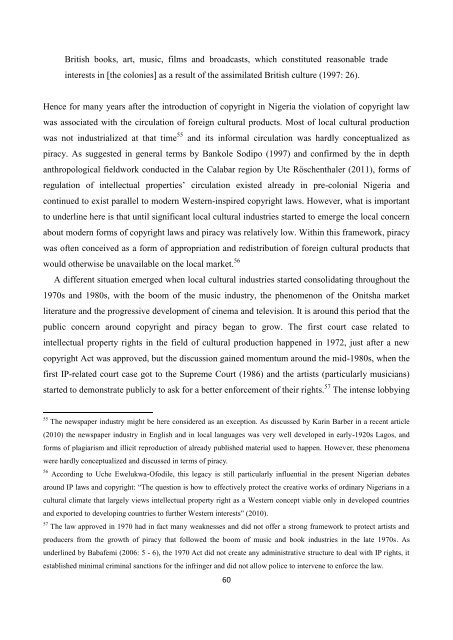Create successful ePaper yourself
Turn your PDF publications into a flip-book with our unique Google optimized e-Paper software.
British books, art, music, films and broadcasts, which constituted reasonable tradeinterests in [the colonies] as a result of the assimilated British culture (1997: 26).Hence for many years after the introduction of copyright in Nigeria the violation of copyright lawwas associated with the circulation of foreign cultural products. Most of local cultural productionwas not industrialized at that time 55 and its informal circulation was hardly conceptualized aspiracy. As suggested in general terms by Bankole Sodipo (1997) and confirmed by the in depthanthropological fieldwork conducted in the Calabar region by Ute Röschenthaler (2011), forms ofregulation of intellectual properties’ circulation existed already in pre-colonial Nigeria andcontinued to exist parallel to modern Western-inspired copyright laws. However, what is importantto underline here is that until significant local cultural industries started to emerge the local concernabout modern forms of copyright laws and piracy was relatively low. Within this framework, piracywas often conceived as a form of appropriation and redistribution of foreign cultural products thatwould otherwise be unavailable on the local market. 56A different situation emerged when local cultural industries started consolidating throughout the1970s and 1980s, with the boom of the music industry, the phenomenon of the Onitsha marketliterature and the progressive development of cinema and television. It is around this period that thepublic concern around copyright and piracy began to grow. The first court case related tointellectual property rights in the field of cultural production happened in 1972, just after a newcopyright Act was approved, but the discussion gained momentum around the mid-1980s, when thefirst IP-related court case got to the Supreme Court (1986) and the artists (particularly musicians)started to demonstrate publicly to ask for a better enforcement of their rights. 57 The intense lobbying55 The newspaper industry might be here considered as an exception. As discussed by Karin Barber in a recent article(2010) the newspaper industry in English and in local languages was very well developed in early-1920s Lagos, andforms of plagiarism and illicit reproduction of already published material used to happen. However, these phenomenawere hardly conceptualized and discussed in terms of piracy.56 According to Uche Ewelukwa-Ofodile, this legacy is still particularly influential in the present Nigerian debatesaround IP laws and copyright: “The question is how to effectively protect the creative works of ordinary Nigerians in acultural climate that largely views intellectual property right as a Western concept viable only in developed countriesand exported to developing countries to further Western interests” (2010).57 The law approved in 1970 had in fact many weaknesses and did not offer a strong framework to protect artists andproducers from the growth of piracy that followed the boom of music and book industries in the late 1970s. Asunderlined by Babafemi (2006: 5 - 6), the 1970 Act did not create any administrative structure to deal with IP rights, itestablished minimal criminal sanctions for the infringer and did not allow police to intervene to enforce the law.60
















